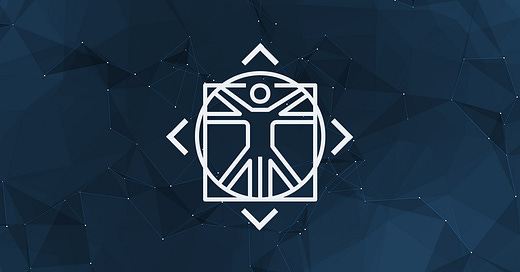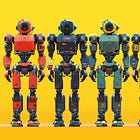From Oil to AI: The Middle East's Rise as a New AI and Tech Hub - Sync #485
Plus: Google to flag AI-generated images; new AI laws in California; Cruise is back in Bay Area; drones to fly between hospitals in London; 23andMe independent board directors resigns; and more!
Hello and welcome to Sync #485!
The focus of this week’s issue of Sync is the recently announced investments and partnerships between the US and Gulf states in AI, which may turn the region into a new hub for AI and tech.
In other news, Neuralink has received the FDA's breakthrough device tag for their implant aimed at restoring vision.
Over in AI, Google will begin flagging AI-generated images in Search later this year, and California has passed new laws addressing deepfakes and actor clones. Meanwhile, OpenAI is threatening to ban users who probe too deeply into the inner workings of their latest model, o1.
In robotics, Cruise robotaxis have returned to the Bay Area after a one-year exile, and drones will soon begin ferrying blood between two hospitals in London.
We’ll conclude this week’s issue with news of a new open-source AI drug discovery system and the latest challenges facing 23andMe.
Enjoy!
From Oil to AI: The Middle East's Rise as a New AI and Tech Hub
Oil has made Gulf states like the UAE and Saudi Arabia extremely wealthy in the 20th century. However, at some point, the last barrel of oil will be extracted, and the Gulf states are preparing to transition into their post-oil future by diversifying their economies.
These countries have enormous resources, which they invest in becoming world centres for business, tourism, and culture. Additionally, they also aim to become hubs for tech startups and attract top talent to build companies there. Positioning as a world-class centre for AI companies is designed to help achieve this goal.
These plans seem to be working, as they have already attracted the attention of both major companies and new players, seeking opportunities for investment or new partnerships worth billions of dollars.
BlackRock and Microsoft to raise $30 billion for AI investments
This week, BlackRock and Microsoft announced partnership with the UAE's MGX investment vehicle to raise $30 billion in private equity for the development of AI-related data warehouses and energy infrastructure, with plans to leverage this to $100 billion in potential investments. The partnership, called the Global AI Infrastructure Investment Partnership, aims to meet the massive demand for data centers and AI infrastructure. The infrastructure investments will be mostly in the US, with a portion of the funds to be deployed in US partner countries.
Key collaborators include Global Infrastructure Partners (being acquired by BlackRock for $12.5 billion) and Nvidia, which will contribute its expertise in AI data centers. Additionally, the companies will invest in expanding energy infrastructure, including renewable energy sources like solar and wind, to meet the growing demand for energy to run AI data centers.
Microsoft’s partnership with G42 expands
The partnership with BlackRock and MGX is not the only one Microsoft is involved in within the Middle East. The tech giant is also building on its existing $1.5 billion partnership with UAE-based AI firm G42 by opening two new AI centres in Abu Dhabi. The first, co-founded and co-funded by G42 and Microsoft, with the endorsement of Abu Dhabi’s Artificial Intelligence and Advanced Technology Council, will focus on developing best practices and industry standards for the responsible use of AI in the Middle East and the Global South. The second is the expansion of Microsoft’s AI for Good Research Lab into Abu Dhabi, which will support AI projects that address key societal goals.
Groq and Saudi Aramco
Other US companies are also looking at the Middle East for business partnerships. One of them is Groq, an AI chip startup, which signed an agreement with Saudi Aramco, the world’s largest oil company, to build the world’s largest inferencing data centre in Saudi Arabia using Groq’s Language Processing Units (LPUs). This data centre is expected to process billions of tokens per day by the end of 2024 and then increase the throughput to hundreds of billions of tokens per day by 2025.
Middle East as a new AI and tech hub
These investments and partnerships signal an interesting trend in the global AI ecosystem. Currently, the field is dominated by the US and China, where most research, innovation, investment, and application of AI are concentrated. Now, a new tech hub in the Middle East is emerging, attracting billions of dollars in investments and the tech talent needed to build companies there.
The recent partnerships are not just business deals—they also carry geopolitical implications. As tensions between the US and China grow, particularly in AI and tech, the US is leveraging these partnerships to strengthen ties with Middle Eastern tech ecosystems. By doing so, it seeks to counter China’s growing influence in AI across the Global South. Moreover, amid the geopolitical turbulence in the Middle East, these AI partnerships may also serve as a form of tech diplomacy, providing the US with alternative channels to influence regional politics.
If you enjoy this post, please click the ❤️ button or share it.
Do you like my work? Consider becoming a paying subscriber to support it
For those who prefer to make a one-off donation, you can 'buy me a coffee' via Ko-fi. Every coffee bought is a generous support towards the work put into this newsletter.
Your support, in any form, is deeply appreciated and goes a long way in keeping this newsletter alive and thriving.
🦾 More than a human
Musk's Neuralink gets FDA's breakthrough device tag for 'Blindsight' implant
Neuralink announced that its experimental vision-restoring implant, Blindsight, has received the FDA's "breakthrough device" designation, which is given to certain medical devices that provide treatment or diagnosis of life-threatening conditions. This designation is aimed at speeding up the development and review of devices currently under development. Blindsight is designed to help individuals, even those who have lost both eyes and their optic nerve, regain vision.
🧠 Artificial Intelligence
OpenAI to Decide Which Backers to Let Into $6.5 Billion Funding
OpenAI’s reported $6.5 billion funding round is nearing completion, and apparently the interest in that funding round is so high that OpenAI can essentially choose who will be part of the deal. According to Bloomberg, the excess demand was in the billions of dollars, and some investors will find out soon if they did make the cut.
Google will begin flagging AI-generated images in Search later this year
Google plans to introduce changes to Google Search that will flag AI-generated or AI-edited images as such within the next few months. A similar change is also coming to Google Lens and Android’s Circle to Search. It is a move in the right direction, as deepfakes contribute to scams and the spread of misinformation. However, this new flag will be displayed in the “About this image” section, not on the search results page. Additionally, the flagging system will rely on C2PA metadata, which is not yet widely adopted, and can be removed or corrupted.
California’s 5 new AI laws crack down on election deepfakes and actor clones
California Governor Gavin Newsom is reviewing 38 AI-related bills aimed at addressing various concerns in the use of AI. Key laws he has already signed include criminalising the use of AI-generated deepfake nudes for blackmail (SB 926) and mandating platforms to allow reporting and removal of such content (SB 981). New legislation also targets election-related deepfakes, requiring platforms to label or remove deceptive content (AB 2655, AB 2839), and mandates transparency for AI-generated political ads (AB 2355). Additionally, new media industry standards prevent unauthorised AI replicas of actors, both living and deceased. Newsom still has 30 bills to decide on, including the highly debated SB 1047.
Ban warnings fly as users dare to probe the “thoughts” of OpenAI’s latest model
Apparently, OpenAI does not like it when people try to uncover the “inner thoughts” of their latest model, o1. Some people who attempted to figure out how o1 works received an email from OpenAI, warning them that their actions were violating policies against circumventing safeguards or safety measures, and that they could lose access to the o1 model if they continue probing into the model.
Will the "AI Scientist" Bring Anything to Science?
Among the many applications of AI, one of the most intriguing is the concept of an AI scientist. "The AI scientist seems to capture the zeitgeist," the article notes, explaining how these tools work by generating hypotheses, running experiments, and writing papers. While they demonstrate performance comparable to an early PhD student, these AI systems are far from perfect—they frequently produce flawed ideas, struggle with coherent writing, and sometimes fabricate data. Despite these challenges, there is optimism about their potential in scientific research, especially in fields where experiments can be simulated.
Challengers Are Coming for Nvidia’s Crown
Nvidia dominates the AI hardware landscape. However, new challengers are emerging to claim pieces of Nvidia’s empire. This article lists and briefly introduces some of those contenders, such as AMD, Intel, Cerebras, SambaNova, Groq, Qualcomm, various hyperscalers, and Chinese companies.
Omnipresent AI cameras will ensure good behavior, says Larry Ellison
Speaking during a financial meeting, Larry Ellison, the billionaire co-founder of Oracle, shared his vision of a world in which AI-powered surveillance systems, including drones and cameras, would monitor citizens to ensure lawful behaviour. Ellison suggested AI would analyse footage from various sources to automatically detect and report crimes, while drones could replace police vehicles in pursuits. Welcome to our cyberpunk future.
Apple working on next-gen humanlike AI ‘personality’ that’s not Siri
According to recent reports, Apple is working on a new AI assistant that is not Siri. This new generative AI-based personality is intended for Apple's upcoming robotics products, expected to debut in 2026 or 2027.
▶️ AI can't cross this line and we don't know why. (24:06)
In this video, Welch Labs explains the neural scaling laws, which predict the improvements in the performance of neural networks as they scale up in size, data, and computational resources. It is one of the key concepts in modern deep learning, and it gave OpenAI the confidence to try training a truly large model that would eventually become GPT-3. I highly recommend this video if you are curious about how large language models work.
▶️ The Economics of AI are Failing, But We Can Fix It (With Lasers) (28:31)
Dr. Ian Cutress discusses the economic challenges of scaling AI and machine learning, focusing on large language models and the need to ensure profitability at every layer, from hardware to services. In this insightful analysis, he explores the future of the industry as models grow larger and more complex, with agentic workflows on the horizon. These models will require new levels of computing performance, pushing the industry to rethink how future AI supercomputers are built. Cutress suggests that traditional electrical connections may no longer suffice, and optical links could play a crucial role in enabling the high-speed data transfer necessary to support these large-scale AI systems efficiently.
If you're enjoying the insights and perspectives shared in the Humanity Redefined newsletter, why not spread the word?
🤖 Robotics
Cruise robotaxis return to the Bay Area nearly one year after pedestrian crash
In October 2023, Cruise was forced to halt its robotaxi services in California after an incident where a robotaxi struck a pedestrian. Now, almost a year later, Cruise can resume operations in Sunnyvale and Mountain View. Initially, human-driven vehicles will perform mapping, with plans for supervised autonomous testing later this autumn. The move follows a settlement with California regulators and leadership changes at Cruise, along with new funding from General Motors. Since the crash, Cruise has updated its software, scrapped its purpose-built robotaxi, and expanded operations to Phoenix and Dallas, while also partnering with Uber to bring its AVs to the platform by 2025.
Face to face with Figure’s new humanoid robot
In this article, TechCrunch visits Figure, one of the leading companies in the humanoid robotics space. In the 16 months since their last visit in May 2023, the company has grown to 130 employees, reached a $2.6 billion valuation, released the second iteration of their robot, and successfully completed a trial program with BMW. Brett Adcock, the CEO of Figure, shares plans to introduce a humanoid robot for home use and aims to reach a sub-$20,000 price point.
Londoners will soon see drones ferrying blood between hospitals
Apian, Alphabet’s Wing, and the National Health Service are beginning a six-month pilot programme testing the feasibility of using drones to transport urgent blood samples between two hospitals in London. This initiative aims to reduce delivery times from over 30 minutes by road to under two minutes by air, cutting CO2 emissions and improving healthcare efficiency. If successful, the programme could expand to other regions in the UK and Ireland.
To be more useful, robots need to become lazier
The concept of "lazy robotics," championed by René van de Molengraft, focuses on building robots that prioritise relevant data while ignoring unnecessary information. This approach aims to improve efficiency, reduce energy consumption, and enhance decision-making. The article illustrates how this concept helped Molengraft’s team win at RoboCup, an annual international robotics and AI competition, where robots' skills, such as coordination and strategy, are tested on the soccer field. This method has broader applications beyond soccer, such as in industrial robotics and AI-driven automation systems.
▶️ Meet Isaac, the first robot assistant built for the home (0:32)
Weave Robotics is a startup that emerged seemingly out of nowhere, offering what they claim is the “world’s first personal robot built for the home.” As is typical for these kinds of startups, Weave has a sleek website and video where they present what their robot, Isaac, can do. And it can do a lot, from tidying up messes on floors and feeding pets to fetching drinks, food, and other items, according to Weave. The robot will cost $59,000, and the company is currently accepting $1,000 refundable deposits with first robots scheduled to be delivered in late 2025. I’m sceptical, but I will watch their progress with great interest.
▶️ The Carpentopod table being put to use! (0:17)
This is one of the most interesting robots I have seen in a while. My first thought when I saw it was, “It is a Strandbeest.” My second thought was, “It’s almost like Luggage from Discworld.”
🧬 Biotechnology
23andMe independent board directors resign en masse
Last year was not a good time for 23andMe. In December 2023, the genetic testing company was hacked, resulting in the personal information of 6.9 million people being leaked. The company’s stock has dropped more than 95% since it went public in 2021. And now, all seven independent directors of 23andMe have resigned in protest of CEO Anne Wojcicki's efforts to take the company private.
OpenAI, Thrive Capital Back Six-Month-Old AI Drug Discovery Startup
Chai Discovery, a six-month-old AI biology startup, has raised nearly $30 million in funding from Thrive Capital and OpenAI to advance drug discovery using AI. Its first open-source model, Chai-1, shows a 10-20% improvement over leading models like AlphaFold.
Where did viruses come from? AlphaFold and other AIs are finding answers
Using tools like AlphaFold and Meta's ESMFold, scientists are decoding the evolutionary history of viruses, particularly the flavivirus family, which includes dengue, Zika, and hepatitis C. A recent study on flaviviruses, highlighted in this article, uncovered surprising evolutionary links and revealed instances of "genetic piracy," where viruses may have stolen enzymes from bacteria. These findings could reshape our understanding of viral evolution and have important implications for vaccine development.
Thanks for reading. If you enjoyed this post, please click the ❤️ button or share it.
Humanity Redefined sheds light on the bleeding edge of technology and how advancements in AI, robotics, and biotech can usher in abundance, expand humanity's horizons, and redefine what it means to be human.
A big thank you to my paid subscribers, to my Patrons: whmr, Florian, dux, Eric, Preppikoma and Andrew, and to everyone who supports my work on Ko-Fi. Thank you for the support!
My DMs are open to all subscribers. Feel free to drop me a message, share feedback, or just say "hi!"










